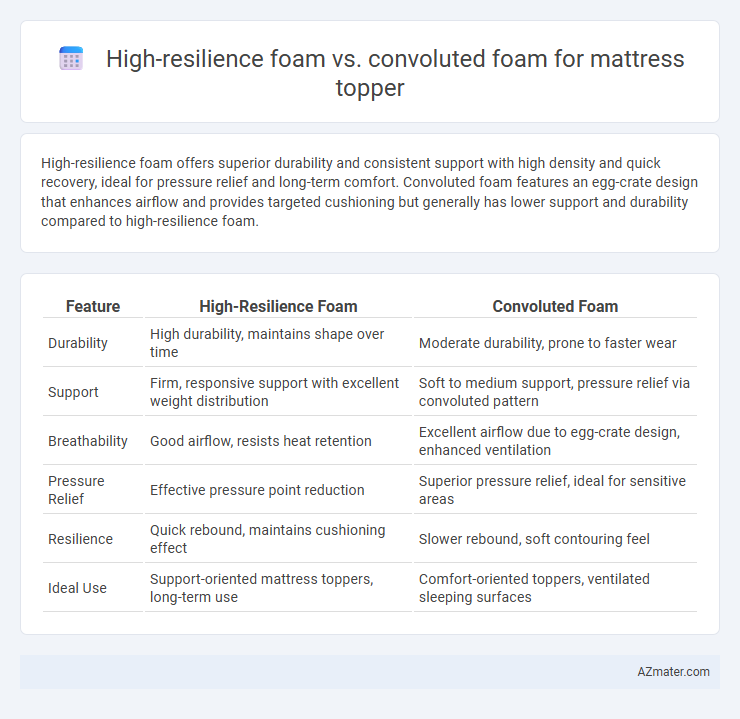High-resilience foam offers superior durability and consistent support with high density and quick recovery, ideal for pressure relief and long-term comfort. Convoluted foam features an egg-crate design that enhances airflow and provides targeted cushioning but generally has lower support and durability compared to high-resilience foam.
Table of Comparison
| Feature | High-Resilience Foam | Convoluted Foam |
|---|---|---|
| Durability | High durability, maintains shape over time | Moderate durability, prone to faster wear |
| Support | Firm, responsive support with excellent weight distribution | Soft to medium support, pressure relief via convoluted pattern |
| Breathability | Good airflow, resists heat retention | Excellent airflow due to egg-crate design, enhanced ventilation |
| Pressure Relief | Effective pressure point reduction | Superior pressure relief, ideal for sensitive areas |
| Resilience | Quick rebound, maintains cushioning effect | Slower rebound, soft contouring feel |
| Ideal Use | Support-oriented mattress toppers, long-term use | Comfort-oriented toppers, ventilated sleeping surfaces |
Introduction to Mattress Topper Foams
High-resilience foam is known for its durability, responsiveness, and consistent support, making it ideal for mattress toppers that require long-lasting comfort and pressure relief. Convoluted foam, also called egg crate foam, features a unique contoured surface that enhances airflow and provides targeted cushioning, which helps to reduce heat retention and improve breathability. Both foam types offer distinct benefits for mattress toppers, with high-resilience foam excelling in support and longevity, while convoluted foam enhances ventilation and comfort.
What is High-Resilience Foam?
High-resilience foam is a type of polyurethane foam known for its durability, excellent support, and quick recovery from compression, making it ideal for mattress toppers. Its open-cell structure promotes better airflow and breathability compared to convoluted foam, enhancing comfort by preventing heat retention. This foam type provides robust pressure relief and maintains its shape longer, offering superior support for a restful sleep experience.
What is Convoluted Foam?
Convoluted foam, also known as egg crate foam, features a distinctive egg-crate pattern designed to enhance airflow and provide targeted pressure relief by conforming to body contours. High-resilience foam offers greater durability and support with a responsive, buoyant structure that maintains its shape over time. Comparing the two, convoluted foam excels in breathability and cushioning, while high-resilience foam provides superior resilience and long-lasting support for mattress toppers.
Key Differences: High-Resilience vs Convoluted Foam
High-resilience foam offers superior durability and support due to its dense, elastic structure that quickly regains shape, making it ideal for pressure relief and long-term use. Convoluted foam, characterized by its egg-crate surface, enhances airflow for temperature regulation and provides a softer, more cushioning sensation. The key difference lies in high-resilience foam's focus on resilience and support versus convoluted foam's emphasis on breathability and gentle comfort.
Support and Comfort Comparison
High-resilience foam offers superior support and durability due to its dense cell structure, providing consistent pressure relief and maintaining shape over time, ideal for those seeking firm yet comfortable mattress toppers. Convoluted foam, characterized by its egg-crate design, enhances airflow and delivers targeted cushioning by conforming to body contours, which promotes comfort but may compress faster under heavy use. Choosing between these foams depends on prioritizing long-term support with high-resilience foam or enhanced breathability and immediate comfort with convoluted foam.
Durability and Longevity
High-resilience foam offers superior durability and longevity due to its dense cellular structure that maintains shape and support over extended use. Convoluted foam, characterized by its egg-crate design, provides moderate durability but tends to compress and lose its resilience faster under consistent weight. Choosing high-resilience foam ensures a longer-lasting mattress topper that resists sagging and deterioration.
Breathability and Temperature Regulation
High-resilience foam offers superior breathability due to its open-cell structure, enhancing airflow and preventing heat buildup for effective temperature regulation. Convoluted foam, with its egg-crate design, promotes localized air circulation by increasing surface area, which helps in reducing heat retention. Both materials improve mattress topper comfort, but high-resilience foam generally provides a more consistent cooling effect throughout the night.
Suitability for Different Sleep Positions
High-resilience foam offers excellent support and durability, making it ideal for back and stomach sleepers who require consistent firmness and spinal alignment. Convoluted foam, with its egg-crate design, provides enhanced airflow and pressure relief, which suits side sleepers by cushioning shoulders and hips while maintaining breathability. Both foams accommodate various sleep positions but target different comfort needs: high-resilience foam emphasizes support, whereas convoluted foam prioritizes contouring and ventilation.
Price and Value Considerations
High-resilience foam mattress toppers typically offer greater durability and support at a higher price point, reflecting their capacity to maintain shape and provide consistent comfort over time. Convoluted foam toppers, while more affordable, deliver moderate pressure relief and airflow but may compress faster, potentially requiring replacement sooner. Evaluating long-term value involves balancing upfront cost with the expected lifespan and support performance of the foam material.
Which Foam is Best for Your Mattress Topper?
High-resilience foam offers superior durability and responsiveness, making it ideal for those seeking firm support and pressure relief in a mattress topper. Convoluted foam provides enhanced airflow and targeted comfort with its egg-crate design, which is beneficial for reducing heat retention and improving breathability. Choosing the best foam depends on your preference for support level, durability, and cooling properties to achieve optimal sleep comfort.

Infographic: High-resilience foam vs Convoluted foam for Mattress topper
 azmater.com
azmater.com